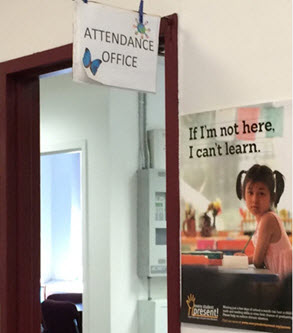


Establish an Infrastructure of Early Supports for Chronically Absent Students...
A school infrastructure is needed to ensure attendance is monitored, chronically absent students are identified and supports are provided to them.
This infrastructure can build on what schools already have in place. For example, many schools use a prevention-oriented, tiered approach to identify students with academic or behavioral challenges (e.g., PBIS). This can be modified to include students with attendance challenges.
The poster below and other materials can be downloaded from this website. See Resource section.

The individual designated by the principal to promote a positive culture of attendance may also be responsible for coordinating regularly scheduled meetings (weekly or bi-weekly) in partnership with the principal. The purposes of these meetings are to:
In addition to the principal, other attendance team members may include social workers, community liaisons, student support staff, school nurses, attendance teachers, and school-based mentors.
The NYC Principals' Guide provides detailed information about how to implement attendance teams in your schools.
Note: The attendance team's focus needs be on ongoing, positive engagement. Therefore, this team should not be responsible for any enforcement procedures.
Enhance Student Engagement with Mentors Who Personalize Supports...
Mentors can successfully promote school engagement among students who are chronically absent and reduce the amount of time students miss school.
Putting mentoring programs in place
The goals of mentoring are to:
(1) engage students through personal relationships with adults;
(2) identify reasons students are not attending school; and
(3) work with school staff who can link students and families to supports that help address reasons for poor attendance (e.g., health, transportation).
Students who are chronically absent are identified using the NYS Education Department SIRS reports and mentors are assigned to the students.
Typically, mentors are teachers, school aides, parent liaisons, guidance counselors, social workers and administrators.
Source: aha! Process
One district began by asking teachers to assume responsibility for being a mentor to up to 5 students. The coordinator of the mentor program worked with a local coffee shop and was able to provide $10 gift cards to the teachers.
Mentors have a small group of students for whom they are responsible. It is the responsibility of the mentor to meet their students individually and in small groups. Mentor-to-student ratios commonly used:
Examples of mentor responsibilities include activities where mentors:
The NYC Success Mentor Corps Guide provides detailed information about how to implement a mentor program in your schools.
Advisory: 22 Ways to Build Relationships for Educational Success
Help Students Develop Skills that Ease their Attendance Challenges...
The practices described here have been used with chronically absent students who experience school anxiety; however, they are constructive for all students, if resources permit.
Source: Great Schools
Advance Student Supports Through Staff Development...
Another way to promote student engagement among youth who are chronically absent is to build students' social-emotional skills. Students with healthy social-emotional development are better equipped to handle new experiences they encounter in school. Community organizations partnering with schools could be a source of funding for staff development.
Source: Beyond Bulling Summit
Source: PATHS
Restorative practices use a community process for supporting those in conflict. The restorative circle brings together the three main parties to a conflict – those who have acted, those directly impacted and the wider community – within an intentional systemic context, to dialogue as equals. Participants invite each other and attend voluntarily. The dialogue process used is shared openly with all participants, and guided by a community member. The process ends when actions have been found that bring mutual benefit.
Use a Community School Lens to Support Students and Families...
Incorporate Resolution Supports...
Some students may continue to have attendance challenges even when supports are repeatedly provided. The goal of school staff is to maintain a positive approach regardless of the level of risk.
Alternatives to suspension ensure students do not miss instruction; these strategies can be especially useful for some older students who have academic challenges and may skip school or act out in class in an effort to be suspended, hoping to avoid school work.
Source: wiia.org
School-Family Mediation Counseling, like that provided by Community Dispute Resolution Centers across the state, can be used with students who are repeatedly chronically absent. In an effort to maintain a positive approach, an external mediator is invited to work with family members and school staff to handle conflict in a constructive manner and resolve a dispute by finding mutually acceptable solutions.